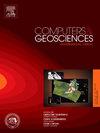VIF-Net: Interface completion in full waveform inversion using fusion networks
IF 4.2
2区 地球科学
Q1 COMPUTER SCIENCE, INTERDISCIPLINARY APPLICATIONS
引用次数: 0
Abstract
Deep learning full waveform inversion (DL-FWI) distinguishes itself from traditional physics-based methods for its robust nonlinear fitting, rapid prediction, and reduced reliance on initial velocity models. However, existing end-to-end deep learning approaches often neglect the reconstruction of layer interfaces and faults. In this article, we propose a two-stage DL-FWI approach named Velocity Interface Fusion (VIF). The first stage comprises two subnetworks: VIF-Velocity (VIF-V) generates the intermediate velocity model, and VIF-Interface (VIF-I) predicts velocity model interfaces. They have the same UNet++ architecture and an optional Fourier transform-based preprocessing module. Their main difference lies in the binary class-balanced cross-entropy loss tailored for VIF-I. The second stage is fulfilled by a fusion subnetwork with a limited downsampling encoder–decoder structure. This network refines the intermediate velocity model using the predicted interfaces to reconstruct the final model. A dynamic learning strategy combining warm-up and cosine annealing is employed to train all three subnetworks jointly. Our method is evaluated on two SEG salt and four OpenFWI datasets using four metrics in comparison with three popular DL-FWI methods. Results demonstrate its superior performance in interface completion and reconstruction. The source code is available at https://github.com/FanSmale/VIF-dev.
使用融合网络完成全波形反演的接口
深度学习全波形反演(DL-FWI)以其鲁棒的非线性拟合、快速预测和减少对初始速度模型的依赖而与传统的基于物理的方法区别开来。然而,现有的端到端深度学习方法往往忽略了层接口和故障的重建。在本文中,我们提出了一种名为速度接口融合(VIF)的两阶段DL-FWI方法。第一阶段包括两个子网:VIF-Velocity (VIF-V)生成中间速度模型,VIF-Interface (VIF-I)预测速度模型接口。它们具有相同的UNet++体系结构和可选的基于傅立叶变换的预处理模块。它们的主要区别在于为VIF-I量身定制的二元类平衡交叉熵损失。第二阶段由具有有限下采样编码器-解码器结构的融合子网完成。该网络利用预测界面对中间速度模型进行细化,重构最终模型。采用预热和余弦退火相结合的动态学习策略对三个子网进行联合训练。我们的方法在两个SEG salt和四个OpenFWI数据集上进行了评估,使用四个指标与三种流行的DL-FWI方法进行了比较。结果表明,该方法在界面补全和重构方面具有优异的性能。源代码可从https://github.com/FanSmale/VIF-dev获得。
本文章由计算机程序翻译,如有差异,请以英文原文为准。
求助全文
约1分钟内获得全文
求助全文
来源期刊

Computers & Geosciences
地学-地球科学综合
CiteScore
9.30
自引率
6.80%
发文量
164
审稿时长
3.4 months
期刊介绍:
Computers & Geosciences publishes high impact, original research at the interface between Computer Sciences and Geosciences. Publications should apply modern computer science paradigms, whether computational or informatics-based, to address problems in the geosciences.
 求助内容:
求助内容: 应助结果提醒方式:
应助结果提醒方式:


